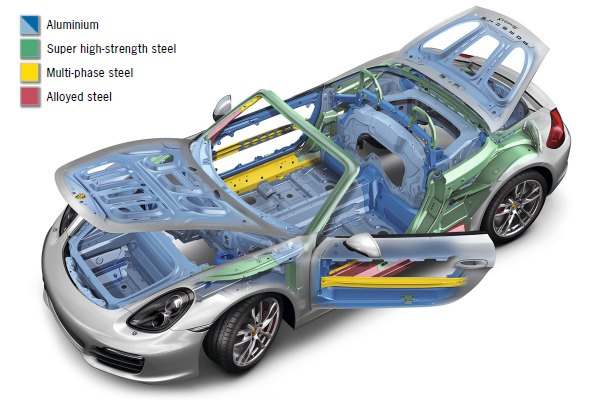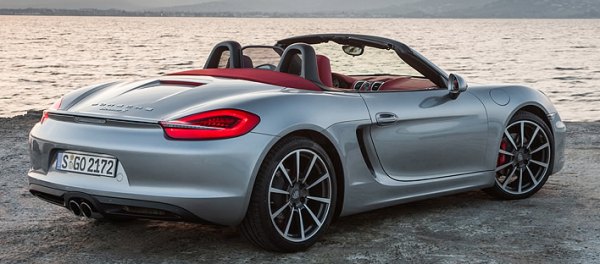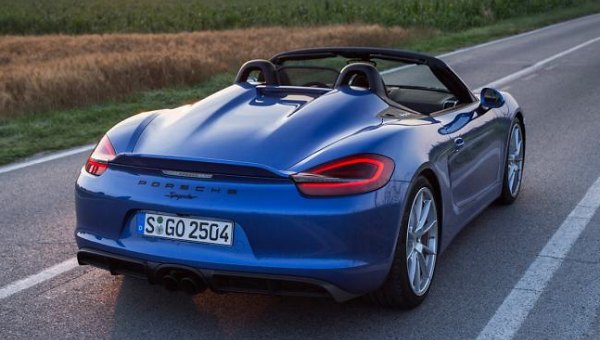|
|
|
Published
on 15
Jun 2012
|
All rights reserved.
|
|
|
1996 was a critical
year
to Porsche. The world's biggest sports car maker ran into deep
financial crisis as its old model lines no longer attracted customers.
Production of 968 and 928 had been terminated a year ago due to their
high ages. The air-cooled 993 was still competitive, but could no
longer sustain the whole company. Sales dropped to a new low of 15,000
cars a year, dragging the company closer to extinction. At this moment,
all hopes were put upon a turnaround plan consisting of 2 radical new
models. The first one being a new entry-level roadster called 986
Boxster. The second was an all-new 911 with codename 996. They were
launched just a year apart. Despite of their different engine
positions, they actually shared a third of parts – in
particular the headlamps, windscreen, bonnet, doors, suspension and
engine bits – so to lower breakeven points. The Boxster's 2.5-liter 204
hp engine might not deliver very high performance, but it shared much
of the 911's charm and build quality while its mid-engined chassis
returned even better handling. This made it incredibly bargain beside
the 911 which cost double the price. Anyway, both models were found
popular and moved Zuffenhausen back to prosperity. The rest was history.
How quickly time goes by! 16 years have passed and the Boxster has come
to its first full remodel (the 987 was merely a mid-life facelift, by
the way). Porsche chose a reverted codename of 981 to coincide with the
new 991 with which it shares major components. Nice, as their
relationship is just as easy to remember as 986 vs 996 and 987 vs 997.

The new
Boxster is easily recognizable as a Boxster, without question, but
Michael Mauer managed to make it more modern. Benefited by a longer
wheelbase (+60 mm), lower roofline (-13 mm), shorter front overhang, a
more cab-forward profile (the windscreen has been moved forward
considerably) and a slightly raised tail, in addition to those larger
side scoops, the new Boxster looks almost like a mini-Carrera GT ! Yes,
it finally possesses a proper mid-engined sports car proportion, unlike
the old car whose front end always looked too long. Meanwhile, its
look distances further apart from 911, thanks to unique headlamps
and doors. At the back, a tiny spoiler that runs across the new-shape
taillights is a stylish touch. The new body keeps a drag coefficient of
0.30 (or 0.31 for Boxster S) which is excellent for a cabriolet.
Like the new 911, the chassis is an aluminum-steel hybrid construction.
From the picture below you can see aluminum comprises of 46 percent of
the whole body-in-white. These parts include outer panels like front
bonnet, engine lid and doors as well as stressed structure like
floorpan, bulkheads, door frames, the frame for mounting rollover hoops
and nearly the whole front and rear structures. (note: if you compare
this picture with the one in our 991 review,
you will find both cars share the same front structure and
front bulkhead. Probably the same bonnet, too.) High-strength steel and
baron steel are used mainly around the survival cell to provide the
necessary crash protection at minimum space engagement. Besides, the
dash support and the frames of soft roof are made of magnesium.
Overall, torsional rigidity has been lifted by 40 percent from the old
car, while kerb weight has been cut by 25-35 kg with all things
considered.

The Boxster still employs all-struts suspensions. This seem lack of
sophistication, but given the car's lightweight, good weight
distribution and its track records of excellent tuning, there is really
no need to switch to double-wishbone type suspensions. That said, its
handling has been enhanced with wider tracks (up 40 mm front and 18 mm
rear) and a string of new technologies coming from 911, such as PASM
adaptive damping, PTV torque-vectoring braking (which works in
conjunction with a mechanical LSD) and magnetorheological adaptive
engine/transmission mounts. The 911's ZF electromechanical power
steering
is a more controversial introduction. Its prime purpose is not to save
fuel
but to enhance the possibility of tuning and simplify the installation
(no need of hydraulic circuit to run from engine to front axle). On the
green side, the new Boxster introduces automatic engine stop-start,
on-demand engine cooling, brake energy regeneration and a coasting
feature on PDK-equipped cars. EU combined consumption is therefore
reduced
by 15 percent.
The engine of Boxster S is familiar. Practically the same 3.4-liter
direct-injected flat-six as the last one, just gets tuned intake and
exhaust to liberate another 5 horsepower. With a total of 315 hp, it
still trails the same motor on old-style Cayman S, let alone the 350 hp
unit on the base 991 Carrera. Self-restriction is still
present on this car to protect the sales of its pricier siblings.
Performance is slightly improved to 173 mph and 0-60 mph in 4.9 seconds
in case of 6-speed manual. Tick PDK and Sport Chrono Plus package
(including launch control), 0-60 is down to 4.6 seconds. Meanwhile, the
base Boxster takes even a step backward by using a smaller, 2.7-liter
engine instead of the previous 2.9. The addition of direct injection
managed to lift its top-end power by 10 ponies, but maximum torque
suffers a drop of 8 pound-foot to 206. Porsche claims much the same
performance as the old Boxster. On the plus side, the base Boxster's
CO2 emission drops below the 200 g/km
mark for the first time. With PDK
equipped, it is a remarkable 180 g/km. The Boxster S PDK is equally
impressive at 188 g/km.
As expected, the cabin borrows a lot from the new 911 thus
it is a vast improvement from the old car in terms of quality and
technology, if not style. Ergonomics are improved, too. A rising center
console enables the gearstick to be located closer to the steering
wheel, making gearshift even handier. The new seats offer excellent
lateral support. They are also mounted slightly lower, offer more
vertical and longitudinal adjustment so that drivers of all sizes can
find a comfortable driving position. Cabin space is excellent, as the
longer wheelbase affords additional legroom. As far as a 2-seat
roadster is concerned, this cabin is faultless.
The new soft top is good, too. Its operation is now fully automatic,
saving the need to unlatch it from the windscreen header. It takes only
9 seconds to open or stow, down from 12 sec. An additional layer of
fabric cuts noise by half. Its magnesium frames cut weight and help
lowering center of gravity a little. Like the new 911 Cabriolet, the
roof now stows directly into a space behind the cockpit without needing
a covering panel. This saves weight, although it hampers the sleekness
of the body surface a little.

All
things are new yet so familiar. This is the first impression it gives
you on the road. Fire the 3.4-liter boxer engine, you are greeted with
the same sharp response and musical exhaust note. The engine is as
free-revving as ever. If there is any difference, it must be an even
quicker throttle response and slightly stronger mid-range punch. The
6-speed manual is also as sweet-shifting as ever, actually much better
than the 7-speed manual on 911. The PDK is definitely an improvement
over the old one, responding to multiple downshifts far more crisply
and ultimately provides faster acceleration. However, it is still no
match with the high level of satisfaction brought by the 6-speed
manual. The shorter distance between the steering wheel and the shifter
enhances this satisfaction further.
The handling is as sensational as ever. This car has better balance
than the 991, not only on paper but also easily felt on the road. It
does not under or oversteer on normal roads, just follow the line you
instruct it to go. Traction, grip and braking are all first rate.
Directional stability is greatly improved with the extended wheelbase.
Stability in corner is even more remarkable than the old car, thanks to
its wider tracks as well as a sturdy structure. This structure also
brings a ride refinement and cabin calmness way beyond the level of the
old 987, which was hardly ordinary in this respect. Its ride is
noticeably more supple, especially with PASM. Some say the new-found
refinement and stability hurt the honest and "tossable" feel of the old
car a little. That might be right from purist point of view, but
considering the enhanced cornering prowess, accuracy and comfort it
brought, I would say it is a wise compromise. Remember, we are dealing
with the standard Boxster and Boxster S now. They are designed for
everyday road use rather than track days. If Porsche wants to please
hardcore drivers, it can easily produce more extreme derivatives in the
future. Think of Boxster Spyder, for example, or sister car Cayman S
and Cayman R.

The
same
argument can be found on its electrical power steering. Purists say it
has lost the tactile feedback of the old hydraulic rack – those tiny
vibrations due to the micro surface texture of the tarmac. The EPS has
such little information filtered out and leaves only the "usable"
feedback of cornering forces and front wheel grip to the driver's
hands. This mean on the straight ahead position your hands are not
overloaded with feel. The 991 met with the same criticism, too.
However, it is undeniable that the loss of tactile feedback has no
effect to how you steer the car, because once you turn the wheel it
weighs up beautifully. The response, accuracy and linearity are beyond
criticism. In fact, the Boxster's rack feels a little more lively than
the 911's already, so it hits a better balance between involvement and
refinement.
Even if you are not convinced by the EPS, the new Boxster S is still
undeniably the best all-round roadster money can buy. Its combination
of superb chassis, engine and gearbox with everyday usability, comfort
and build quality is unrivaled in the marketplace. What about the base
Boxster? It is also a lovely car, albeit with too little power to
exploit its highly talented chassis. If you can afford the extra
£8K, the 3.4-liter model is a must have.
|
Verdict:
Boxster     ;
Boxster S ;
Boxster S      |
Published
on 4
Jul 2015
|
All rights reserved.
|
|
Boxster Spyder
|
|

|
Like the last generation
Boxster Spyder, the new car is likely to be the ultimate evolution of
the current (981) Boxster before the next generation car (718) arrived
next year. It is also the fastest, the best driving and the most
beautiful version of the current generation.
Where should we start? From the exterior, of course. The Spyder follows
its predecessor to ditch the standard electric soft top with a
lightweight, manually operated item. It is stowed under a very stylish
double-dome rear deck which mirrors classic race cars. For style, this
is already a good reason to buy the Spyder, which costs about 12
percent more than the next dearest Boxster, GTS. However, the style
comes at the expense of convenience. This lightweight fabric roof does
not insulate noise and heat as good as the standard item. Moreover, to
open or close is quite a hard work. You need to get out of the car,
detach the attachment points, open the rear deck, fold the roof, secure
it and close the deck. It is more time-consuming than the old Boxster
Spyder because the new design can withstand the car’s top speed of 180
mph, whereas the old one surrendered at 124 mph.
The main reason for the switch to manual roof is that it saves 11
kilograms. It goes without saying the new Boxster Spyder is again a
stripped out edition. It has lost air conditioning (saves 9 kg),
infotainment system, most sound insulation (5 kg) and PASM adaptive
dampers (another 5 kg), so the whole car is 30 kg lighter than the GTS.
That said, in the view of global warming most
buyers are likely to add air-con, which is no-cost option. As before,
the door grab handles have been replaced with fabric door pulls to
emphasize its pursuit of lightweight. Ditto the thin bucket seats.
Following the footprints of Cayman GT4, the Boxster Spyder gets the
3.8-liter engine previously reserved for 911 Carrera S. It is rated
slightly lower at 375 hp and 310 lbft, but there is no reason to assume
it is inferior. With an extra 45 hp and noticeably more mid-range
torque to spend, in addition to reduced weight, the Spyder feels easily
faster than the existing GTS. Even though its transmission is limited
to 6-speed manual – like Cayman GT4, it ditches PDK to please hardcore
drivers – it is capable to sprint from rest to 60 mph in 4.3 seconds.
Mind you, this is no musclecar. Porsche’s naturally aspirated flat-six
always wants you to rev it to get the best results. The closer it gets
to the 7800 rpm redline the better it sounds. The slick and short-throw
gearshift rewards your hardwork.
However, the Boxster Spyder is no GT4. That car is not only benefited
with extra chassis rigidity but also the suspensions, steering and
brakes from 911 GT3. The Spyder is not the product of motorsport
department, so its suspensions are modified from the standard GTS, with
stiffer setting and a 20 mm drop of ride height. Its larger brakes come
from 911 Carrera S, while faster ratio steering comes from 911 Turbo.
On a track or fast open road, the Spyder is not as fast or as precise
as the Cayman GT4. On tighter mountain roads the gap gets closer, but
the coupe is still obviously a more focused driving machine.
Compared with the lesser Boxster GTS, however, the Spyder corners
faster, sharper and harder. Its thinly insulated roof and cockpit
amplify the sound of the 3.8 engine, delivering a rawer and more
thrilling experience. It is unquestionably the best driving Boxster of
all, even though the leap is not as big as from Cayman GTS to GT4. As a
day-to-day companion it is not so good. The extra engine and road noise
could be tiresome, and the manual roof is inconvenient. That said, ride
quality is pretty good despite the lack of adaptive damping. The
Boxster Spyder is not an everyone's choice. It is designed for those
willing to sacrifice comfort and convenience for driving excitement and
a beautiful look.
|
Verdict:      |
|
|
|
|
|
|
|
|
|
|
| Boxster |
2012
|
Mid-engined,
RWD
|
| Steel+aluminum monocoque |
Steel+aluminum
|
| 4374 / 1801 / 1282 mm |
| 2475 mm |
| Flat-6 |
| 2706 cc |
DOHC 24 valves, VVT+VVL
|
| - |
| DI |
| 265 hp / 6700 rpm |
| 206 lbft / 4500-6500 rpm |
6-speed manual or
7-speed twin-clutch
|
All struts
|
Adaptive damping
|
F: 235/45ZR18
R: 265/45ZR18 |
6M: 1310 kg
PDK: 1340 kg
|
6M: 164 mph (c)
PDK: 162 mph (c)
|
6M: 5.5 (c) / 5.6*
PDK: 5.2 (c)
|
6M: 13.1 (c) / 13.3*
PDK: 12.7 (c)
|
|
| Boxster S |
2012
|
Mid-engined,
RWD
|
| Steel+aluminum monocoque |
| Steel+aluminum |
| 4374 / 1801 / 1282 mm |
| 2475 mm |
| Flat-6 |
| 3436 cc |
DOHC 24 valves, VVT+VVL
|
| VIM |
| DI |
| 315 hp / 6700 rpm |
| 265 lbft / 4500-5800 rpm |
6-speed manual or
7-speed twin-clutch
|
All struts
|
Adaptive damping
|
F: 235/40ZR19
R: 265/40ZR19 |
6M: 1320 kg
PDK: 1350 kg
|
6M: 173 mph (c)
PDK: 172 mph (c)
|
6M: 4.9 (c) / 4.4*
PDK: 4.6 (c) / 4.2* / 4.7** /
4.1***
|
6M: 11.0 (c) / 10.5*
PDK: 10.7 (c) / 10.4* / 11.4** /
10.3***
|
|
| Boxster GTS |
2014
|
Mid-engined,
RWD
|
| Steel+aluminum monocoque |
| Steel+aluminum |
| 4404 / 1801 / 1273 mm |
| 2475 mm |
| Flat-6 |
| 3436 cc |
DOHC 24 valves, VVT+VVL
|
| VIM |
| DI |
| 330 hp / 6700 rpm |
| 273 lbft / 4500-5800 rpm |
6-speed manual or
7-speed twin-clutch
|
All struts
|
Adaptive damping
|
F: 235/35ZR20
R: 265/35ZR20 |
6M: 1345 kg
PDK: 1375 kg
|
6M: 174 mph (c)
PDK: 173 mph (c)
|
6M: 4.8 (c)
PDK: 4.5 (c) / 4.1*
|
6M: -
PDK: 10.1*
|
|
|
|
|
|
Performance
tested by: *C&D, **Autocar, ***R&T
|
|
|
|
|
|
|
| Boxster Spyder
|
2015
|
Mid-engined,
RWD
|
| Steel+aluminum monocoque |
| Steel+aluminum |
| 4414 / 1801 / 1262 mm |
| 2475 mm |
| Flat-6 |
| 3800 cc |
DOHC 24 valves, VVT+VVL
|
| VIM |
| DI |
| 375 hp / 6700 rpm |
| 310 lbft / 4750-6000 rpm |
6-speed manual
|
All struts
|
-
|
F: 235/35ZR20
R: 265/35ZR20 |
1315 kg
|
180 mph (c)
|
4.3 (c) / 4.0*
|
9.1*
|
|
|
|
|
|
|
|
Performance
tested by: *C&D
|
|
|
|
|
|
|
|
|
Copyright©
1997-2015
by Mark Wan @ AutoZine
|
|